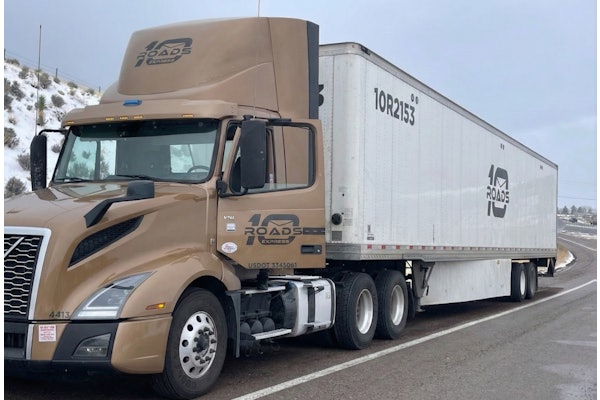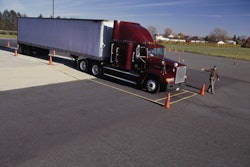Dana Corp. has signed an agreement with SmarTire Systems to market and sell SmarTire’s tire pressure and temperature monitoring systems to commercial truck, bus and RV OEMs in North America.
ConocoPhillips has introduced 76 Triton Heavy Duty ATF, a synthetic
automatic transmission fluid for buses, medium-duty trucks and heavy-duty municipal vehicles.
The OEM Truck Business Unit of Webb Wheel Products has opened a facility in Cullman, Ala., to meet increasing demand for wheel-end products.
According to the Lubes ‘n’ Greases Report, ExxonMobil has reached an exclusive five-year agreement to supply finished lubricants to Caterpillar.
The American Transportation Research Institute has received a $500,000 grant from the U.S. Environmental Protection Agency to study engine idling-reduction technologies.
Arrow Truck Sales has finalized an agreement with National Truck Protection to enhance Arrow’s extended warranty options. Changes include the addition of two new, more comprehensive, 24-month/200,000-mile plans.
In response to damage caused by hurricanes Katrina and Rita, Stemco has released a tech tip to address the inspection, rebuilding and reassembly of submerged tractor and trailer wheel ends. Visit this site for more information.
The Holland Group has introduced landing gear with Black Armour, a technology designed to combat corrosion.
The 2006 Shell Rotella SuperRigs calendar, which features eye-catching photographs of heavy trucks in scenic locations, is available free of charge at this site.
Mack Trucks says that ABS-6, a next-generation antilock braking system from Bendix Commercial Vehicle Systems, now is available on its highway models.
So, I’m riding shotgun in a fully loaded tractor-trailer, doing about 60 mph. A car is just about stopped in our path, and we’re closing fast. Yet the driver makes no attempt to slow down. As we get impossibly close, the truck takes matters into its own hands, applies full braking, and we’re quickly brought to a well-controlled stop, some 25 feet from the car’s bumper.
An accident was avoided – two, actually, if you count my near personal one. Thank DaimlerChrysler’s latest version of its “Telligent” proximity control, one of 50-some technologies demonstrated recently by the company at its 2005 Technology Days at the massive Papenburg test facility in northwestern Germany.
The emergency braking system uses three radar beams of the proximity control system to detect moving obstacles in a truck’s path, and continuously calculates the difference in speed between the two vehicles. When an accident is imminent, the driver first receives a visual dash warning, followed by an audible warning.
If the risk of a collision increases, 30 percent of braking power is applied as a further warning. If the driver still doesn’t react, the system automatically applies full braking power.
While this system will be introduced in Europe on the Mercedes-Benz Actros truck range next year, an enhanced version, which can distinguish among five levels of road grip and respond accordingly, already is being tested.
As these systems require electronic braking (EBS), there’s no telling when they might be available in North America, but I’d say the sooner the better.
Other safety, environmental and convenience technologies demonstrated at the event included steering intervention, automatic trailer coupling, a driverless road construction warning vehicle, hybrid and fuel cell drive power, suspension advances and many more. Watch these pages over the coming months for more news from Papenburg.
Hanging by a thread
Because traditional fasteners are susceptible to self-loosening rotational movement, stripping and shearing, their use in critical joints without additional locking methods isn’t always appropriate, according to engineers at Dana Corp. Testing, they say, has shown that the first two threads of traditional fasteners can carry as much as 80 percent of the load, leading to stripping or shearing, while subsequent male threads float within the female threads.
For critical, front-drive-axle applications, the engineers settled on the use of Spiralock fasteners. What makes them unique is a 30-degree wedge ramp cut at the root of the female thread (traditional fasteners use a 60-degree thread).
Under clamp load, the crests of the threads on any standard male bolt are drawn tightly against Spiralock’s wedge ramp, eliminating sideways motion that causes vibrational loosening, and distributing the threaded joint’s load throughout all engaged threads.
Deliver or Retrieve your equipment easier
Meet the Retriever – a different kind of truck bed for transporting heavy construction and industrial equipment. Claimed benefits include light weight, low deck height, power from the truck’s own air system instead of hydraulics, and more payload per shift.
The Retriever can move heavier payloads with smaller vehicles, says manufacturer Up-N-Atom of Waukesha, Wis. Non-CDL trucks can handle payloads as high as 13,000 pounds, while tandems can haul a full 30,000 pounds.
Because the lifetime-warranted Retriever’s deck is curved and hinged, a loading angle of 10.8 to 13.5 degrees (19- to 24-percent grade) can be achieved, depending on truck specs. Additionally, the curved deck eliminates “breakover” when loading tracked equipment.
The Retriever can be ordered with dual, lightweight, aluminum slide-out ramps; or a full-width, air-operated, steel folding ramp. It’s available in three capacity ratings: 7.5 tons for chassis to 30,000 lb. GVWR; 10 tons for chassis to 33,000 lb. GVWR; and 15 tons for chassis to 54,000 lb. GVWR. All models are available in 18- to 26-foot lengths in two-foot increments.
Customers typically buy a new or used truck chassis and have the Retriever installed at the company’s Waukesha plant or through designated contractors in the United States and Canada. For more information, visit this site.
Seeing the light
Why hasn’t someone thought of this before? Waytek’s new line of fuses has an LED that lights up when the fuse is blown, making for easy identification of blown fuses, especially in hard-to-reach fuse blocks. The fuses come in ATO and ATM styles, and are color-coded to indicate amperage rating.
For more information or to request a free updated catalog, call Waytek at 800-328-2724 or visit this site.
Equipment Puzzler
In September’s issue, we asked: When torquing a nut or bolt, why should you lubricate the threads?
John Mitchell of Tampa, Fla., a shop supervisor for Southeastern Freight Lines, answered: “You lubricate the threads to get an even/true torque. If they were not lubricated, it could bind just enough to give an improper torque reading.”
He’s right. Since torque is only an indicator of clamping force, thread friction can make that indicator artificially high, while clamping force isn’t where it should be.
John will receive a chrome CCJ pen and Air Brake Book. You can, too, if you’re the first to e-mail the correct answer to this month’s Puzzler to [email protected], or if you send in a Puzzler of your own and we use it.
This month’s Puzzler:
What are two advantages of helical gears in drive-axle ring-and-pinions?









